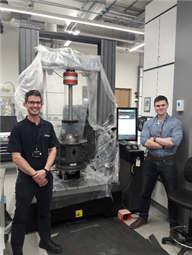All but one of the UK’s operating nuclear power stations are Advanced Gas-cooled Reactors (AGRs) which contain around 3,000 graphite fuel bricks forming part of the reactor core. The fuel assemblies are periodically raised and lowered through these bricks as part of the normal operation of the reactor, for example when refuelling is required. Whenever a fuel assembly is raised or lowered, the load on the fuel hoist and the height of the fuel is recorded. This information is known as a fuel grab load trace (FGLT).
As the fuel assembly is charged or discharged there is friction between the brushes and the graphite bricks. The load seen is directly influenced by the diameter of the channel and so small variations in the size of the channel bore and across interfaces between bricks are recorded as variations in load on the FGLT. This is important as it is one of the ways EDF gathers information on the state of the reactor core in between inspections to ensure safe and efficient operation.
EDF was keen to simulate defects which might occur - but have not been identified so far - to see if and how they might be identified on a load trace.
 NPL worked with Atkins, on behalf of EDF, to perform a series of tests over a two-week period on a rig which simulated bricks found within some of the AGR cores. Using a new Instron 5985 250 kN machine, a wire brush with an interference fit with the graphite fuel bricks was raised and lowered, simulating ‘charging’ and ‘discharging’ of a fuel stringer. By observing the load trace captured during this process, EDF could compare the NPL results with traces taken from reactors during refuelling.
NPL worked with Atkins, on behalf of EDF, to perform a series of tests over a two-week period on a rig which simulated bricks found within some of the AGR cores. Using a new Instron 5985 250 kN machine, a wire brush with an interference fit with the graphite fuel bricks was raised and lowered, simulating ‘charging’ and ‘discharging’ of a fuel stringer. By observing the load trace captured during this process, EDF could compare the NPL results with traces taken from reactors during refuelling.
During the testing, the graphite bricks were configured to simulate fragment-producing defects which might be seen in reactors as they age. The testing took account of the different brick geometries in different AGR cores, and the resulting issues which may result due to these differences. The ‘simulated conditions’ allowed greater understanding of how defects might influence the FGLT.
The Instron test machine was also able to detail accurately and precisely where on the FGLT the introduced fragments or debris voids might be detected and what they might look like. This has the potential to highlight any changes in core condition during routine refuelling operations.
The testing was carried out in the newly refurbished Mechanical Test Facility by the Advanced Materials Characterisation group. The job was carried out by NPL and Atkins, on behalf of EDF; on time, to budget and with excellent feedback from the customer.
NPL’s new Mechanical Test Facility will have 6 new static and 8 new dynamic test machines complimenting and enhancing the capabilities of the current laboratory. It will offer traceability to national standards and extremely accurate readings over a wide range of loads, conditions and test methods that when combined with NPL’s experience in uncertainty of measurement will ensure confidence in results.
The high resolution of NPL’s new Instron load cell, particularly at low loads, has allowed EDF to identify the effect on the load trace of small graphite fragments protruding into the channel. Comparing these to traces taken in reactor conditions will allow EDF to make a judgement about what will be seen if similar fragments are produced in the reactor. This is of the utmost importance to ensure the safe operation of the plant and accurate reporting to the UK nuclear safety regulator, the ONR.
To find out more about graphite in the AGRs visit EDF’s website.